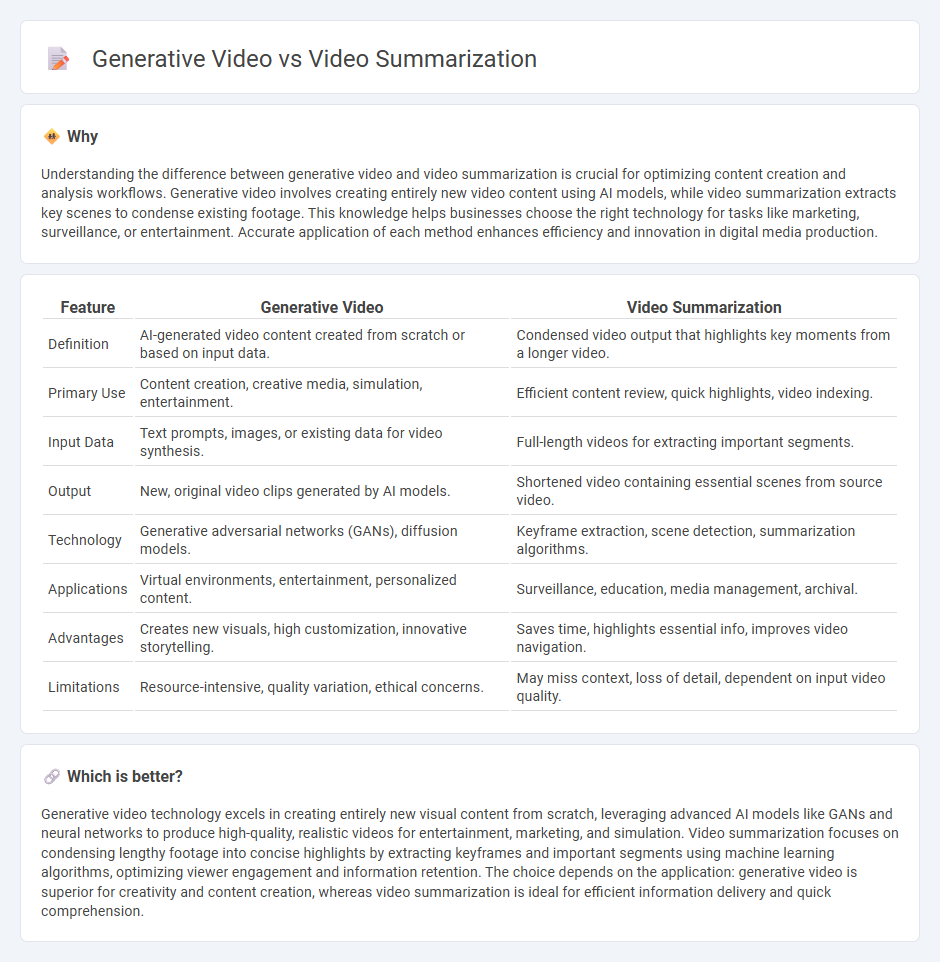
Generative video leverages advanced AI models to create entirely new video content from textual or visual input, enhancing creativity and automation in media production. Video summarization focuses on extracting key moments from existing footage, improving efficiency in content consumption and quick information retrieval. Explore the latest advancements to understand how these technologies reshape digital storytelling and media workflows.
Why it is important
Understanding the difference between generative video and video summarization is crucial for optimizing content creation and analysis workflows. Generative video involves creating entirely new video content using AI models, while video summarization extracts key scenes to condense existing footage. This knowledge helps businesses choose the right technology for tasks like marketing, surveillance, or entertainment. Accurate application of each method enhances efficiency and innovation in digital media production.
Comparison Table
| Feature | Generative Video | Video Summarization |
|---|---|---|
| Definition | AI-generated video content created from scratch or based on input data. | Condensed video output that highlights key moments from a longer video. |
| Primary Use | Content creation, creative media, simulation, entertainment. | Efficient content review, quick highlights, video indexing. |
| Input Data | Text prompts, images, or existing data for video synthesis. | Full-length videos for extracting important segments. |
| Output | New, original video clips generated by AI models. | Shortened video containing essential scenes from source video. |
| Technology | Generative adversarial networks (GANs), diffusion models. | Keyframe extraction, scene detection, summarization algorithms. |
| Applications | Virtual environments, entertainment, personalized content. | Surveillance, education, media management, archival. |
| Advantages | Creates new visuals, high customization, innovative storytelling. | Saves time, highlights essential info, improves video navigation. |
| Limitations | Resource-intensive, quality variation, ethical concerns. | May miss context, loss of detail, dependent on input video quality. |
Which is better?
Generative video technology excels in creating entirely new visual content from scratch, leveraging advanced AI models like GANs and neural networks to produce high-quality, realistic videos for entertainment, marketing, and simulation. Video summarization focuses on condensing lengthy footage into concise highlights by extracting keyframes and important segments using machine learning algorithms, optimizing viewer engagement and information retention. The choice depends on the application: generative video is superior for creativity and content creation, whereas video summarization is ideal for efficient information delivery and quick comprehension.
Connection
Generative video leverages artificial intelligence to create new video content by synthesizing images and sequences, while video summarization utilizes AI algorithms to extract and condense key moments from existing footage. Both technologies rely on deep learning models, such as convolutional neural networks and transformers, to analyze video data for pattern recognition and efficient content generation or compression. Their connection lies in enhancing video consumption by enabling automated content creation and delivering concise, relevant summaries tailored to user preferences.
Key Terms
Scene Detection
Scene detection is a crucial technique in video summarization that segments footage into meaningful parts based on visual and temporal cues, enabling concise content representation. Generative video leverages scene detection as a foundation to create new video sequences by synthesizing or altering scenes through AI-driven models, blending original and generated content seamlessly. Explore the latest advancements in scene detection technology to understand its pivotal role in enhancing both video summarization and generative video applications.
Keyframe Extraction
Video summarization utilizes keyframe extraction to represent the essential content of a video by selecting representative frames that capture significant events or scenes, reducing the video's length without losing critical information. Generative video techniques go beyond extraction by creating new frames or sequences based on learned patterns, enabling the synthesis of novel content rather than merely summarizing existing footage. Explore more to understand how advancements in keyframe extraction enhance both video summarization and generative video applications.
Diffusion Models
Diffusion models have revolutionized video generation by enabling high-quality, coherent synthetic videos through progressive noise reduction, outperforming traditional video summarization techniques that condense content by extracting key frames or scenes. While video summarization focuses on compact representation of existing footage, diffusion-based generative video creates entirely new sequences by learning underlying data distributions, enhancing applications in content creation and virtual reality. Explore more about how diffusion models transform video synthesis and summarization methodologies.
Source and External Links
Introducing Summarization.Video - This tool by Gcore uses AI to summarize videos into text, providing full transcripts and multiple levels of condensed summaries.
Video Summarization Techniques - A comprehensive review exploring extractive and abstractive methods for video summarization, highlighting keyframe and keyshot selection techniques.
Screenapp Video Summarizer - This AI-powered tool instantly generates text summaries from videos across major platforms, focusing on key points and essential information.
 dowidth.com
dowidth.com